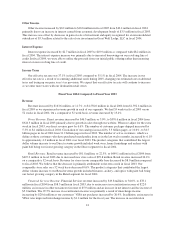Cabela's 2005 Annual Report Download - page 61
Download and view the complete annual report
Please find page 61 of the 2005 Cabela's annual report below. You can navigate through the pages in the report by either clicking on the pages listed below, or by using the keyword search tool below to find specific information within the annual report.consequences may arise. Our failure to comply with the terms of current economic development packages could
result in our repayment of grant money or other adverse consequences that would affect our cash flows and
profitability. As of December 31, 2005 and January 1, 2005, the total amount of grant funding subject to a specific
contractual remedy was $16.6 million and $17.7 million, respectively. Portions of seven of our destination retail
stores, such as wildlife displays and museums, are subject to forfeiture provisions. In addition, there are 30.3 acres
of undeveloped property subject to forfeiture. We expect to forfeit 15.3 acres of this undeveloped property as a
result of not developing or selling this property during the agreed upon period. The 15.3 acres expected to be
forfeited has no basis and therefore the forfeiture will not create an income statement impact.
Economic Development Bonds. Through economic development bonds, the state or local government sells
bonds to provide funding for land acquisition, readying the site, building infrastructure and related eligible
expenses associated with the construction and equipping of our destination retail stores. We typically have been
the sole purchaser of these bonds. The bond proceeds that are received by the governmental entity are then used
to fund the construction and equipping of new destination retail stores and related infrastructure development.
While purchasing these bonds involves an initial cash outlay by us in connection with a new store, some or all of
these costs can be recaptured through the repayments of the bonds. The payments of principal and interest on the
bonds are typically tied to sales, property or lodging taxes generated from the store and, in some cases, from
businesses in the surrounding area, over periods which range between 20 and 30 years. In addition, some of the
bonds that we have purchased may be repurchased for par value by the governmental entity prior to the maturity
date of the bonds. However, the governmental entity from which we purchase the bonds is not otherwise liable
for repayment of principal and interest on the bonds to the extent that the associated taxes are insufficient to pay
the bonds. In one location, the bonds will become subordinated to other bonds associated with the development if
we fail to continue to operate the store over a prescribed period. After purchasing the bonds, we typically carry
them on our balance sheet as “available for sale” marketable securities and value them based upon management’s
projections of the amount of tax revenue that will be generated to support principal and interest payments on the
bonds. We have limited experience in valuing these bonds and, because of the unique features of each project,
there is no independent market data for valuation of these types of bonds. If sufficient tax revenue is not
generated by the subject properties, we will not receive scheduled payments and will be unable to realize the full
value of the bonds carried on our balance sheet. See “—Critical Accounting Policies and Use of Estimates—
Economic Development Bonds” and “Risk Factors—Risks Related to our Merchandising Business—The failure
of properties to generate sufficient taxes to amortize the economic development bonds owned by us that relate to
the development of such properties would have an adverse impact on our cash flows and profitability.” As of
December 31, 2005 and January 1, 2005, we carried $144.5 million and $144.6 million, respectively, of
economic development bonds on our balance sheet.
The negotiation of these economic development arrangements has been important to our destination retail
store expansion in the past, and we believe it will continue to be an important factor to our ability to execute our
destination retail store expansion strategy because we believe they will allow us to avoid or recapture a portion of
the costs involved with opening a new store. If similar packages are unavailable in the future or the terms are not
as favorable to us, our return on investment in new stores would be adversely affected and we may choose to
significantly alter our destination retail store expansion strategy.
Credit Card Loan Securitizations
Our Financial Services segment historically has funded most of its growth in credit card loans through an
asset securitization program. Asset securitization is a practice commonly used by credit card issuers to fund
credit card loans at attractive rates. The bank enters into asset securitization transactions, which involve the
two-tier sale of a pool of credit card loans from the bank to a wholly owned special purpose entity, and from that
wholly owned special purpose entity to a second special purpose entity that is organized as a trust. The trust is
administered by an independent trustee. Because the trust qualifies as a “qualified special purpose entity” within
the meaning of Statement of Financial Accounting Standards No. 140, Accounting for Transfers and Servicing of
Financial Assets and Extinguishments of Liabilities (“SFAS 140”), its assets and liabilities are not consolidated
in our balance sheet in accordance with SFAS 140.
49
























